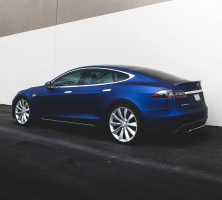
— In a case titled Justine Hsu v. Tesla, the owner of a 2016 Tesla Model S claims Autopilot caused a crash, her injuries and three surgeries.
California resident Justine Hsu says she leased the 2016 Tesla Model S in July 2016 because she believed Autopilot, "would eliminate the risk of harm or injury to the vehicle operator by operating only within marked travel lanes and avoiding other vehicles or obstacles while driving on the roadways."
Hsu says she "further reasonably believed that the Model S was safer than a human-operated vehicle."
The plaintiff also claims Tesla advertises "that all of the self-driving components engineered into the vehicle would prevent injury from driving into a fixed object of any kind."
"The Model S was not to leave a marked travel lane, within the input of the driver, in a way to cause damage, harm, or injury." — Justine Hsu v. Tesla
According to the lawsuit, Hsu was driving her Model S on the morning of July 6, 2019, in Arcadia, California. The plaintiff says because she is petite and 5 feet 2 inches tall, she would typically sit close to the steering wheel and drive with bent elbows so she could see over the steering wheel and reach the foot pedals.
Hsu says she was driving in stop-and-go traffic when she engaged Autopilot because she claims, "drivers frequently engage Autopilot mode when driving in stop-and-go traffic."
The plaintiff says she had both hands on the Model S steering wheel before and after she engaged Autopilot, but about 20 seconds after engaging the feature and while traveling about 25 miles per hour, Autopilot allegedly failed to "see" the center median.
The lawsuit alleges Autopilot malfunctioned which made the Model S swerve and the driver's side tire hit the median curb which deployed the airbags.
Even though the lawsuit says the "collision happened so suddenly that Hsu had no time to react," the lawsuit also claims "she attempted to shield her face from the airbags by releasing her hands from the steering wheel and positioning them in front of her face."
According to the lawsuit, the airbags should not have deployed in that type of collision. However, Hsu claims they did deploy but did not deploy properly, causing her to suffer a broken jaw and the loss of multiple teeth.
She also contends she "suffered injuries to her face, hands, and legs and was bleeding from her hand and mouth."
Court documents allege Tesla knew the Model S was defective from the time the car was sold, but the automaker was allegedly more concerned with profits and didn't warn Hsu the Model S was defective.
"The Model S lacked a properly designed system for crash avoidance, such that Autopilot in fact guided the Model S to seek an obstacle – rather than avoid an obstacle – when the Model S collided with the center median." — Justine Hsu v. Tesla
The lawsuit goes on to say Autopilot failed to detect the median and failed to stay within the driving lane. And the lawsuit claims Tesla's conduct "was despicable, and so contemptible that it would be looked down upon and despised by ordinary decent people."
Justine Hsu v. Tesla: Jury Agrees With Tesla
This lawsuit is considered a "bellwether" case, or a test trial for plaintiffs and their lawyers to have an idea how and if to sue Tesla in similar situations.
If the jury would have found Tesla's Autopilot or airbags had defects which caused the crash and injuries, Tesla could have expected to suddenly receive hundreds of new lawsuits.
However, following a three-week trial where jurors heard from both sides, the jury ruled Tesla wasn't to blame in the $3 million lawsuit.
Tesla always denied it was to blame for the incident because the Model S owner's manual is clear that Autopilot should not be used on city streets, which is exacly what Hsu did. Tesla also referenced the owner's manual which is clear that Autopilot doesn't make the Model S a self-driving car.
According to the jury, the airbags were not defective and they performed safely as intended, and Autopilot did not malfunction as alleged by the plaintiff. In addition, the jury agreed that Tesla was clear that Autopilot is to assist a driver and does not make the car self-driving.
In the end, Hsu received nothing for damages as the jury said distracted driving was the cause of the crash and injuries.
The Tesla Autopilot crash lawsuit was filed in the Los Angeles Superior Court of California: Justine Hsu v. Tesla, et al.
The plaintiff is represented by the Gokal Law Group, Inc.




